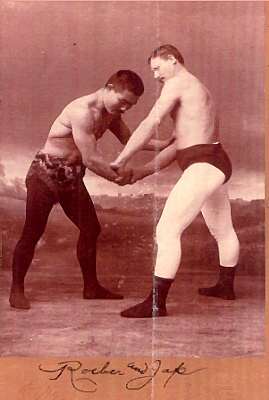Duncan Ross Wrestles Sorakichi Matsuda
Nyob rau hnub tim 21, 1884, Duncan C. Ross met Sorakichi Matsuda, also known as Matsada, the first Japanese professional wrestler in the United States. Matsuda immigrated to the United States to pursue his dream of becoming a professional wrestler because it didn’t really exist in Japan at the time.
28-year-old Duncan Ross was born in Turkey of Scottish descent on March 12, 1856. Ross was skilled in many areas of wrestling. During his career, he was recognized as a champion in catch-as-catch-can, Greco-Roman wrestling, collar-and-elbow wrestling and Cornish wrestling.

Artist yog nqus duncan C. Ross los ntawm ib pob ntawm Allen Minter Luam yeeb circa 1888 (Public sau)
Cornish wrestling was contested in a jacket similar to those worn by Jujitsu and later Judo players. The jacket experience would technically be helpful in Ross’ match with Sorakichi Matsuda.
The match was scheduled to be a 3 tawm ntawm 5 ntog. Two falls would be contested in catch-as-catch-can, two falls would be contested in Japanese wrestling (Jujitsu) and one fall in a style decided by coin flip.
The 25-year-old Matsuda faced the same challenge with Ross that he faced with most wrestlers. Matsuda stood only 5’04” los yog 5’05” and weighed a powerful 165 phaus. Txawm li cas los, he always gave up 25 pounds or more to almost all his opponents including Ross. Ross was also four or five inches taller.
Ross won the first fall in catch-as-catch-can style after 16 feeb. Matsuda won the second fall in Jujitsu in two seconds with a throw. The next two falls went the same way as the first two.
Ross won the coin toss for the fifth fall and breathed a sigh of relief. Matsuda had thrown him twice in less than a minute in the Jujitsu falls, so the contest wouldn’t have gone Ross way if Matsuda won the coin toss.
Matsuda was no slouch at catch-as-catch-can either, so it wasn’t a guarantee of a Ross win but it made it more difficult for Matsuda. The reporter for the Indianapolis Journal stated the match was not a “hippodrome” or pre-arranged exhibition although journalist covering wrestling couldn’t always tell. Txawm li cas los, this match did appear to be a contest.
Sorakichi Matsuda realized he was at a disadvantage, so he used his head to butt Ross several times. Once he butted Ross in the mouth and bloodied his lip. An infuriated Ross started hand fighting and shoulder butting Matsuda around until he was finally able to throw him after 39 minutes of roughhouse wrestling.

Sorakichi Matsuda and Ernst Roeber demonstrating wrestling in the late 1880s
Matsuda would continue wrestling until his early death in 1891 ntawm xwb 32 xyoo. Zoo li ntau tauj kev ncaws pob ua ntej thiab vim hais tias, Matsuda led a hard partying social life outside the ring and it caught up with him at an early age.
Ross wrestled until at least 1888. One of the most respected wrestlers of his age, he was a world title challenger to William Muldoon in Greco-Roman wrestling. Ross also held the American Heavyweight Wrestling Championship in 1881. Nws tuag thaum 63 hnub nyoog rau lub Cuaj hlis xyoo 8, 1919.
Sorakichi Matsuda may have gained his greatest fame in 2 matches with Evan “Strangler” Lewis. Matsuda became famous not for his exploits but for the actions of Lewis, who established himself as the most viscous wrestler of his era.
Koj tuaj tawm tswv yim lossis nug ib lo lus nug hais txog qhov no lossis muaj nqe lus hauv qab no saib hauv qab no lossis rau ntawm kuv Facebook phab.
Qhov chaw: The Indianapolis Journal, Tim 22, 1884 ib tsab, p. 1 thiab wrestlingdata.com
Pin It


